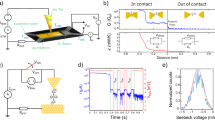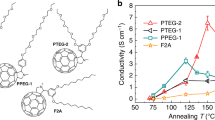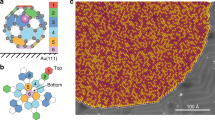Abstract
Molecular junctions are a versatile test bed for investigating nanoscale thermoelectricity1,2,3,4,5,6,7,8,9,10 and contribute to the design of new cost-effective environmentally friendly organic thermoelectric materials11. It was suggested that transport resonances associated with discrete molecular levels could play a key role in thermoelectric performance12,13, but no direct experimental evidence has been reported. Here we study single-molecule junctions of the endohedral fullerene Sc3N@C80 connected to gold electrodes using a scanning tunnelling microscope. We find that the magnitude and sign of the thermopower depend strongly on the orientation of the molecule and on applied pressure. Our calculations show that Sc3N inside the fullerene cage creates a sharp resonance near the Fermi level, whose energetic location, and hence the thermopower, can be tuned by applying pressure. These results reveal that Sc3N@C80 is a bi-thermoelectric material, exhibiting both positive and negative thermopower, and provide an unambiguous demonstration of the importance of transport resonances in molecular junctions.
This is a preview of subscription content, access via your institution
Access options
Subscribe to this journal
Receive 12 print issues and online access
$259.00 per year
only $21.58 per issue
Buy this article
- Purchase on Springer Link
- Instant access to full article PDF
Prices may be subject to local taxes which are calculated during checkout




Similar content being viewed by others
References
Baheti, K. et al. Probing the chemistry of molecular heterojunctions using thermoelectricity. Nano Lett. 8, 715–719 (2008).
Yee, S. K., Malen, J. A., Majumdar, A. & Segalman, R. Thermoelectricity in fullerene metal heterojunctions. Nano Lett. 11, 4089–4094 (2011).
Lee, S. K., Ohto, T., Yamada, R. & Tada, H. Thermopower of benzenedithiol and C60 molecular junctions with Ni and Au electrodes. Nano Lett. 14, 5276–5280 (2014).
Malen, J. A. et al. Identifying the length dependence of orbital alignment and contact coupling in molecular heterojunctions. Nano Lett. 9, 1164–1169 (2009).
Tan, A. et al. Effect of length and contact chemistry on the electronic structure and thermoelectric properties of molecular junctions. J. Am. Chem. Soc. 133, 8838–8841 (2011).
Balachandran, J., Reddy, P., Dunietz, B. D. & Gavini, V. End-group-induced charge transfer in molecular junctions: Effect on electronic-structure and thermopower. J. Phys. Chem. Lett. 3, 1962–1967 (2012).
Widawsky, J. R. et al. Length-dependent thermopower of highly conducting Au–C bonded single molecule junctions. Nano Lett. 13, 2889–2894 (2013).
Chang, W. B. et al. Controlling the thermoelectric properties of thiophene-derived single-molecule junctions. Chem. Mater. 26, 7229–7235 (2014).
Evangeli, C. et al. Engineering the thermopower of C60 molecular junctions. Nano Lett. 13, 2141–2145 (2013).
Kim, S., Jeong, W., Kim, K., Lee, W. & Reddy, P. Electrostatic control of thermoelectricity in molecular junctions. Nature Nanotech. 9, 881–885 (2014).
Zhang, Q., Sun, Y., Xu, W. & Zhu, D. Organic thermoelectric materials: Emerging green energy materials converting heat to electricity directly and efficiently. Adv. Mater. 26, 6829–6851 (2014).
Finch, C. M., García-Suárez, V. M. & Lambert, C. J. Giant thermopower and figure of merit in single-molecule devices. Phys. Rev. B 79, 033405 (2009).
Bergfield, J. P., Solis, M. A. & Stafford, C. A. Giant thermoelectric effect from transmission supernodes. ACS Nano 4, 5314–5320 (2010).
Snyder, G. J. & Toberer, E. S. Complex thermoelectric materials. Nature Mater. 7, 105–113 (2008).
Harman, T. C., Taylor, P. J., Walsh, M. P. & LaForge, B. E. Quantum dot superlattice thermoelectric materials and devices. Science 297, 2229–2232 (2002).
García-Suárez, V. M., Lambert, C. J., Manrique, D. Z. & Wandlowski, T. Redox control of thermopower and figure of merit in phase-coherent molecular wires. Nanotechnology 25, 205402 (2014).
Stevenson, S. et al. Small-bandgap endohedral metallofullerenes in high yield and purity. Nature 401, 55–57 (1999).
Nörenberg, C. et al. Self-assembly and electronic effects of Er3N@C80 and Sc3N@C80 on Au(111) and Ag/Si(111) surfaces. J. Phys. Conf. Ser. 100, 052080 (2008).
Vacek, J., Vacek Chocholoušová, J., Stará, I. G., Starýa, I. & Dubi, Y. Mechanical tuning of conductance and thermopower in helicene molecular junctions. Nanoscale 7, 8793–8802 (2015).
Paulsson, M. & Datta, S. Thermoelectric effect in molecular electronics. Phys. Rev. B 67, 241403(R) (2003).
Agraït, N., Rubio, G. & Vieira, S. Plastic deformation of nanometer-scale gold connective necks. Phys. Rev. Lett. 74, 3995–3998 (1995).
Rubio-Bollinger, G., Bahn, S. R., Agraït, N., Jacobsen, K. W. & Vieira, S. Mechanical propperties and formation mechanisms of a wire of single gold atoms. Phys. Rev. Lett. 87, 026101 (2001).
Ruoff, R. S. & Ruoff, A. L. The bulk modulus of C60 molecules and crystals: A molecular mechanics approach. Appl. Phys. Lett. 59, 1553–1555 (1991).
Ferrer, J. et al. GOLLUM: A next-generation simulation tool for electron, thermal and spin transport. New J. Phys. 16, 093029 (2014).
Soler, J. M. et al. The SIESTA method for ab initio order-N materials simulation. J. Phys. Condens. Matter. 14, 2745–2779 (2002).
Lambert, C. J. Basic concepts of quantum interference and electron transport in single-molecule electronics. Chem. Soc. Rev. 44, 875–888 (2015).
Acknowledgements
This work was supported by the Swiss National Science Foundation (No. 200021-147143) as well as by the European Commission (EC) FP7 ITN ‘MOLESCO’ project no. 606728, UK EPSRC (grant nos. EP/K001507/1, EP/J014753/1, EP/H035818/1), Spanish MINECO (grant nos. MAT2011-25046 and MAT2014-57915-R), Comunidad de Madrid NANOFRONTMAG-CM (S2013/MIT-2850), MAD2D-CM (S2013/MIT-3007) and the Iraqi Ministry of Higher Education, Tikrit University (SL-20). L.R.-G. acknowledges financial support from UAM, IMDEA-Nanoscience and Spanish MECD (grant no. FPU014/03368). A.K.I. acknowledges financial support from Tikrit University.
Author information
Authors and Affiliations
Contributions
L.R.-G. performed the experiments and analysed the experimental data. A.K.I. and I.G. carried out the theoretical calculations. K.P. purified and provided the endohedral molecules. C.E. contributed to the experiments and to the experimental set-up and G.R.-B. contributed to the experimental set-up. N.A. and C.J.L. conceived and supervised the experiment and wrote the manuscript with contributions from all the authors.
Corresponding authors
Ethics declarations
Competing interests
The authors declare no competing financial interests.
Supplementary information
Supplementary Information
Supplementary Information (PDF 1550 kb)
Rights and permissions
About this article
Cite this article
Rincón-García, L., Ismael, A., Evangeli, C. et al. Molecular design and control of fullerene-based bi-thermoelectric materials. Nature Mater 15, 289–293 (2016). https://doi.org/10.1038/nmat4487
Received:
Accepted:
Published:
Issue Date:
DOI: https://doi.org/10.1038/nmat4487
This article is cited by
-
Single-cluster electronics using metallic clusters: Fabrications, regulations, and applications
Nano Research (2024)
-
Third-order nonlinear optical properties of fullerene C60 in organic solvents using femtosecond laser z-scan
Indian Journal of Physics (2023)
-
Room-temperature logic-in-memory operations in single-metallofullerene devices
Nature Materials (2022)
-
Zirconium nitride as a highly efficient nitrogen source to synthesize the metal nitride clusterfullerenes
Science China Chemistry (2021)
-
Thermoelectric rectification in a graphene-based triangular ballistic rectifier (G-TBR)
Journal of Computational Electronics (2021)



